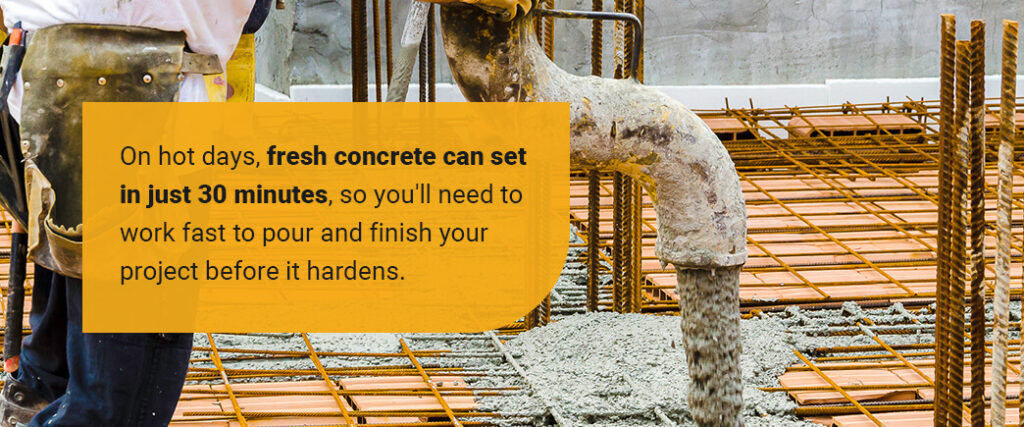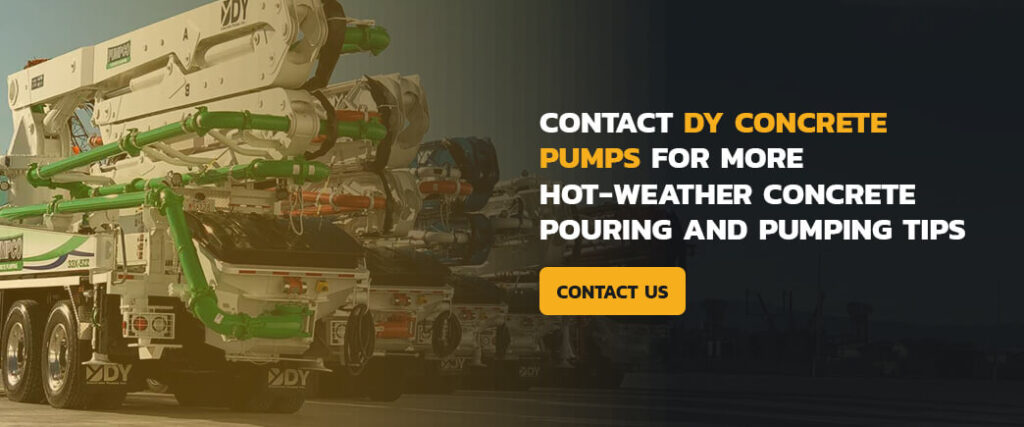How to Pour Concrete in Hot Weather
Posted On: 03/03/2023 | Posted by: DY Concrete Pumps

The summer months typically represent one of the busier times of year for the construction industry, which results in an increased demand for the use of concrete. However, pouring concrete in summer heat presents challenges that are not an issue when working in moderate temperatures.
While pouring concrete in hot weather is possible, you should first take the proper steps to protect your final product. Your projects or concrete repairs won’t always fall during optimal conditions, so learning to work around weather conditions such as intense heat can help you achieve the best outcome and keep your business successful is essential.
Best Temperature for Pouring Concrete
Various elements, such as humidity, wind and temperature, can affect the ability to pour concrete effectively. Ideally, you’ll want to pour concrete between 40 degrees Fahrenheit and 60 degrees Fahrenheit. However, you won’t always have the best temperature for pouring concrete with each job.
There can be challenges when pouring concrete in cold or warm temperatures. For example, when it’s too cold, it can slow chemical reactions that make concrete strong, resulting in a weaker product. Warm temperatures above 77 degrees Fahrenheit can evaporate the water you use to cure or hydrate the cement. As a result, the concrete’s temperature can increase and weaken, making it vulnerable to cracking or shrinking.
There are other obstacles to pouring concrete in hot weather, such as:
- Formation of cold joints, which are areas of weakness in the concrete that can result from the heat decreasing the setting time
- Formation of shrinkage-related cracks that may continue to widen until you can eliminate the stresses causing the shrinkage
- Compression testing revealing a decrease in compression strength, which is often directly related to extreme heat
- Reduced strength and durability that can cause the need for repairs or replacement in the future
- More difficult finishing from placing and pouring concrete during sweltering conditions
- Increased potential for dry shrinkage after hardening, which can negatively impact the quality of the finish
Despite these obstacles, you can effectively pour concrete in the heat using the proper precautions, even working in temperatures above 77 degrees Fahrenheit.

Tips for Pouring Concrete in Hot Temperatures
While summer brings warm, long days ideal for working on projects, it’s not the most friendly environment for concrete. Hot weather isn’t the perfect concrete pouring temperature, but there are ways to avoid the adverse effects of pouring during these highs. On hot days, fresh concrete can set in just 30 minutes, so you’ll need to work fast to pour and finish your project before it hardens.
If you know the temperature will be hot when you’re pouring concrete, it’s best to plan ahead. You can offset the effects of hot weather, wind and humidity by following these tips:
- Choose the best time of day: If possible, avoid pouring concrete during the warmest times of the day — attempt to schedule the pouring during the morning hours. Pouring concrete in the morning helps you avoid the warmest temperatures, which can affect the quality of your finished project. Starting early can help you complete your project quickly without risking your concrete hardening before you’re finished.
- Shade your equipment: Keep all equipment, such as pumps, conveyors and chutes, in a shaded area until you need them, or consider applying protective covers if there is no access to shade. The shade will help reduce the overall temperature of your equipment, which can prevent some of the challenges associated with pouring concrete in the heat.
- Have enough workers on hand: Make sure you have a sufficient workforce to complete the task. A single person is usually insufficient to manage the concrete during pouring, placing and finishing.
- Space control joints properly: Remember that pouring concrete when it’s hot outside requires placing space control joints at smaller intervals than when working in colder conditions.
- Shade the poured concrete: Use sunshades when possible to keep the concrete cooler during and after pouring to prevent it from getting too warm in the sun. Shading your concrete is just as important, if not more, than shading your equipment to ensure it doesn’t dry too quickly before you can finish your project.
- Prevent evaporation: Water will evaporate more quickly as the temperature rises, so equip your laborers with an evaporative retarder to prevent the mix from drying out upon application. You can also combat evaporation by reducing the mixing time after adding water.
- Utilize walls and roofs: Plan on building walls and ceilings before pouring indoor concrete slabs. Keep the side forms for all walls and slabs damp by applying cool water.
- Consider adding ice: Adding ice to the concrete water mixture can keep it cool and also help to safeguard against excess evaporation.
- Wait for the water to dry: Do not commence the finishing process until there is no more water on the substrate’s surface.
- Use the proper curing process: Ensure you implement the most appropriate curing process for the project, as doing so will ensure the concrete sets evenly and uniformly.
Pouring concrete in the heat is possible when using the proper methods and working quickly. Set times will vary depending on the time of year, so you’ll need to prepare depending on the weather you’re expecting. With the proper preparation, you can achieve your ideal results even when the temperatures aren’t optimal.
Contact DY Concrete Pumps for More Hot-Weather Concrete Pouring and Pumping Tips
Pouring concrete in the heat can be complicated, but it’s easier with the right tools. DY Concrete Pumps manufactures concrete pumps for your needs, whether you’re completing a brand-new project or making repairs. Our pumps are created with our clients in mind, meaning they’re easy to use so you can save time, boost productivity and reduce the need for preventative maintenance.
With years of end-user experience in providing the most advanced and reliable concrete pumping machines, we can help you maximize pouring and pumping concrete in hot weather. Contact us to learn more.


 1-844-397-8677
1-844-397-8677



